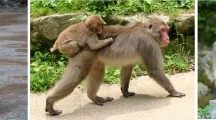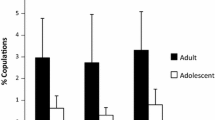Abstract
Non-reproductive copulation, which takes place outside of the mating season and does not result in conception and birth, was studied in a free-ranging group of Tibetan monkeys (Macaca thibetana) at Mt. Huangshan, China, in the birth seasons of 1992 and 1997. We employed all occurrence and focal animal samplings to record sexual and related behaviors and affiliation interactions, respectively. Compared with sexual behavior in mating season, non-reproductive copulation occurred at a lower frequency, with less frequent ejaculation, less harassment, shorter mount duration, and an absence of pause with vocalization. It often took place in a situation in which non-lactating females were involved in social conflict or approached males for mating. Neither pregnant nor lactating females were observed to mate in the birth seasons. Copulation during the birth season did not increase a sexually receptive female’s delivery the next year, nor was it associated with increased proximity, grooming, or agonistic aid for the mating pair. However, copulated pairs spent more time co-feeding, presumably reflecting an increased tolerance on the part of the male. Adolescent males, who rarely copulated in the mating season, engaged in mating activity in birth seasons as well. Therefore, though birth-season copulation had no reproductive functions, it may have fulfilled social functions for females, such as post-aggression appeasing by males or gaining access to resources. This also offered good opportunities for adolescent males and females to develop their sexual skills for later competition.


Similar content being viewed by others
References
Altmann J (1974) Observational study of behavior: sampling methods. Behaviour 49:227–267
Beach FA (1976) Sexual attractivity, proceptivity and receptivity in female mammals. Horm Behav 7:105–138
Berman CM, Li JH (2002) Impact of translocation, provisioning and range restriction on a group of Macaca thibetana. Int J Primatol 23:383–397
Bielert C, Czaja JA, Eisele S, Scheffler G, Robinson JA, Goy RW (1976) Mating in the rhesus monkey (Macaca mulatta) after conception and its relationship to oestradiol and progesterone levels throughout pregnancy. J Reprod Fertil 36:179–187
Deng ZY, Zhao QK (1987) Social structure in a wild group of Macaca thibetana at Mt. Emei, China. Folia Primatol 49:1–10
Dixson AF (1998) Primate sexuality: comparative studies of the prosimians, monkeys, apes, and human beings. Oxford University Press, Oxford
Glick B (1979) Testicular size, testosterone level, and body weight in male Macaca radiata. Folia Primatol 32:268–289
Gomendio M, Harcourt AH, Roldan RS (1998) Sperm competition in mammals. In: Birkhead TR, Moller AP (eds) Sperm competition and sexual selection. Academic, San Diego, pp 667–751
Gordon T (1981) Reproductive behavior in the rhesus monkeys: social and endocrine variables. Am Zool 21:185–195
Gordon T, Rose R, Bernstein I (1976) Seasonal rhythm in plasma testosterone levels in the rhesus monkey (Macaca mulatta): a three year study. Horm Behav 7:229–243
Goy RW (1992) The mating behavior of primates: estrus or sexuality. In: Itoigawa N, Sugiyama Y, Sackett GP, Thompson GKR (eds) Topicsim Primatology, vol 2: Behavior, ecology, and conservation. University of Tokyo Press, Tokyo, pp 151–161
Hamilton WJ, Arrowood P (1978) Copulatory vocalization of chacma baboons (Papio ursinus). Science 200:1405–1409
Hill DA (1987) Social relationships between adult male and female rhesus macaques: 1. Sexual consortships. Primates 28:439–456
Huffman MA (1992) Influence of female partner preference on potential reproductive outcome in Japanese macaques. Folia Primatol 59:77–88
Keverne EB (1981) Do Old World primates have oestrus? Malay Appl Biol 10:119–126
Keverne EB, Michael R (1970) Annual changes in the menstruation of rhesus monkeys. J Endocrin 48:669–670
Li JH (1999) The Tibetan Macaque Society: a field study. Anhui University Press, Hefei
Li JH, Wang QS (1994) Allogrooming in wild Tibetan macaques with special reference to social structure. In: Roeder JJ, Thierry B, Anderson JR, Herrenschmidt N (eds) Current primatology, vol. 2. Universite Louis Pasteur, Strasbourg, pp 185–192
Li JH, Wang QS, Han DM (1996) Fission in a free-ranging Tibetan macaque troop at Huangshan Mountains, China. Chinese Sci Bull 41:1377–1381
Li JH, Yin HB, Wang QS (2005) Seasonality of reproduction and sexual activity in female Tibetan macaques (Macaca thibetana) at Mt. Huangshan, China. Acta Zool Sinica 51:365–375
Lindburg DG (1987) Seasonality of reproduction in primates. In: Mitchell G, Erwin J (eds) Comparative primate biology: behavior, cognition, and motivation. Vol. 2, part B. Alan R. Liss, New York, pp 167–218
Loy J (1971) Estrous behavior of free-ranging rhesus monkeys (Macaca mulatta). Primates 12:1–31
Matsumoto-Oda A (1999) Female choice in the opportunistic mating of wild chimpanzees (Pan troglodytes schweinfurthii) at Mahale. Behav Ecol Sociobiol 46:258–266
Nigi H (1976) Some aspects related to conception of the Japanese monkey (Macaca fuscata). Primates 17:81–87
Nigi H, Hayama SI, Tori R (1990) Copulatory behavior unaccompanied by ovulation in the Japanese monkey (Macaca fuscata). Primates 31:243–250
Nigi H, Tiba T, Yamamoto S, Floescheim Y, Ohsawa N (1980) Sexual maturation and seasonal changes in reproductive phenomena of male Japanese monkeys (Macaca fuscata) at Takasakiyama. Primates 21:230–240
Rostal DC, Glick BB, Eaton GG, Resko JA (1986) Seasonality of adult male Japanese macaques (Macaca fuscata): androgens and behavior in a confined troop. Horm Behav 20:452–462
Siegel S (1956) Nonparametric statistics for the behavioral sciences. McGraw-Hill, New York
Takahata Y (1980) The reproductive biology of a free-ranging troop of Japanese monkeys. Primates 21:303–329
Tanaka T, Tokuda K, Kotera S (1970) Effects of infant loss on the birth interval of Japanese monkeys. Primates 11:113–117
Tutin CEG, McGrew WC (1973) Chimpanzee copulatory behavior. Folia Primatol 19:237–256
Vandenbergh JG (1969) Endocrine coordination in monkeys: male sexual responses to the female. Physiol Behav 4:261–264
Walker ML, Gordon TP, Wilson ME (1983) Menstrual cycle characteristics of seasonally breeding rhesus monkeys. Biol Reprod 29:841–848
Xiong CP (1993) Sexual harassment of copulation in Tibetan monkeys (Macaca thibetana). Acta Theriol Sinica 13:172–180
Xiong CP, Wang QS (1991) A comparison of sexual behaviors between Macaca thibetana and Macaca fuscata. Acta Theriol Sinica 11:13–22
Yin HB, Li JH, Zhou LZ, Ge JZ, Berman CM, Ionica C (2004) A case of birth in winter in a group of Tibetan monkeys at Huangshan. Acta Theriol Sinica 24:18–21
Zhao QK (1993) Sexual behavior of Tibetan macaques at Mt. Emei, China. Primates 34:431–444
Acknowledgements
We thank the Huangshan Monkey Center, Huangshan Garden Forest Bureau and X.M. Chen’s family for permission and/or logistic support to our study. We thank K. Wada and H. Ogawa for their cooperation and assistance in the field. We specially thank C.M. Berman, H. Ogawa, and L. Sun for comments and the English revision. The authors also benefited from discussions with Q.S. Wang, J. Shao, and R.M. Ren. The original manuscript was written at the Laboratory of Human Evolution Studies of the Graduate School of Science in Kyoto University and then finished in the College of the Sciences of Central Washington University. J.H. Li thank T. Nishida and L. Sun for their invitations and hosting. This research was supported by the National Natural Science Foundation of China (NSFC), Key Teacher Program of the Ministry of Education of China, Outstanding Youth Foundation of Anhui, Natural Science Foundation of Anhui, and China Scholarship Council.
Author information
Authors and Affiliations
Corresponding author
About this article
Cite this article
Li, J., Yin, H. & Zhou, L. Non-reproductive copulation behavior among Tibetan macaques (Macaca thibetana) at Huangshan, China. Primates 48, 64–72 (2007). https://doi.org/10.1007/s10329-006-0002-5
Received:
Accepted:
Published:
Issue Date:
DOI: https://doi.org/10.1007/s10329-006-0002-5




